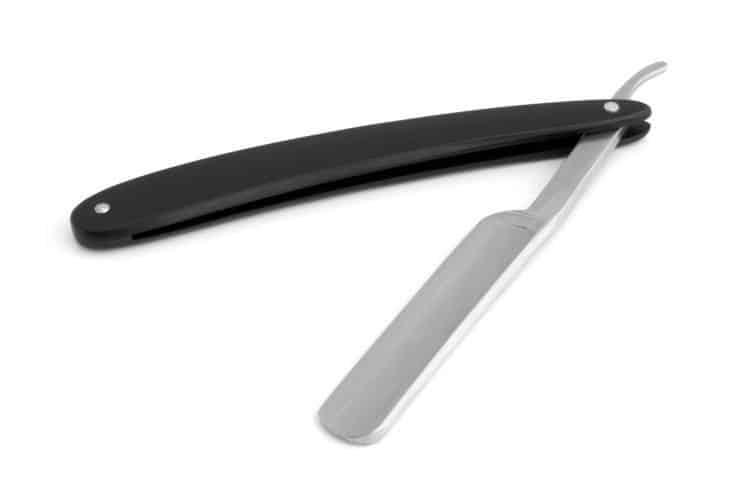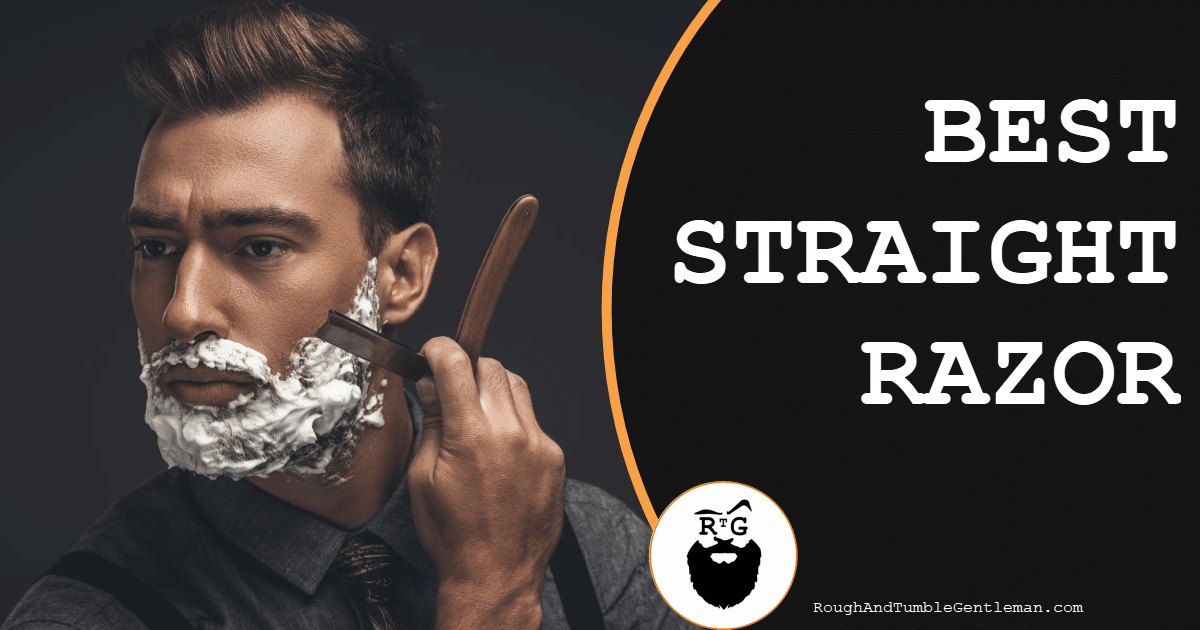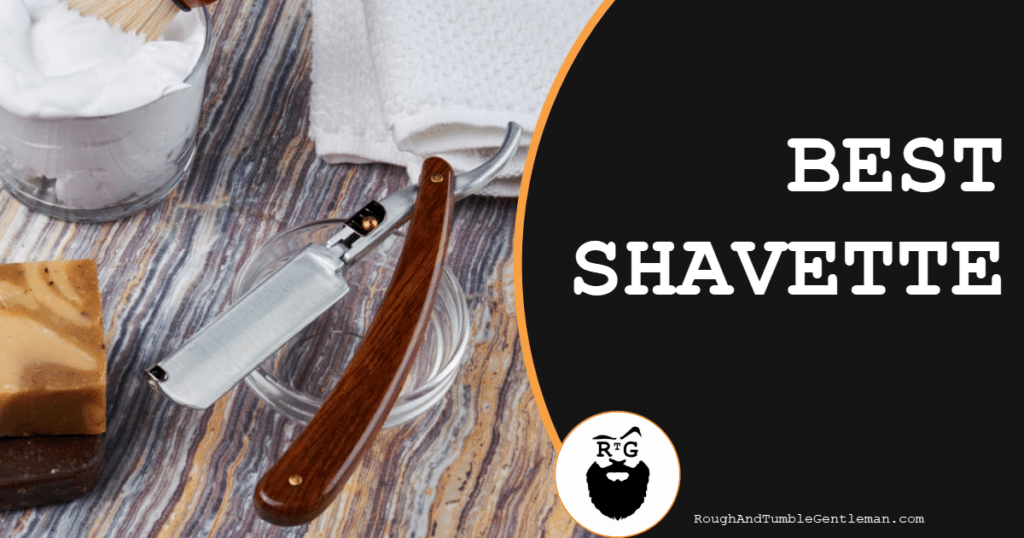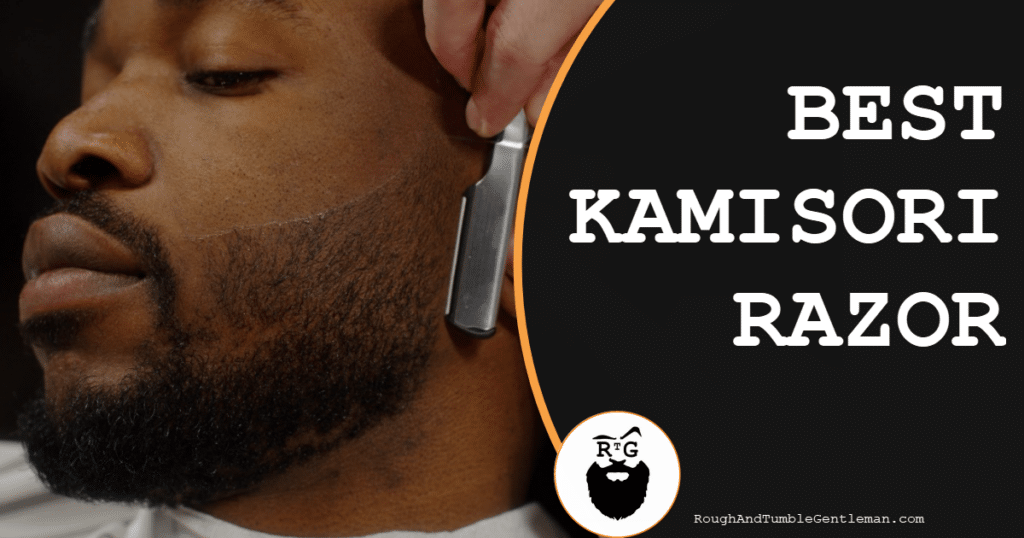Shaving with a straight razor is a time-honored way of male grooming, and in terms of masculinity, it’s on the same plane of manliness as cutting wood with an axe. It takes a lot less effort, too! It is, perhaps, the easiest way to feel manly while standing in front of your mirror draped in a towel, and that’s saying something.
With that in mind, selecting the best straight razor for your needs is an important task. Straight razors can a bit daunting, so you’ll want one that makes sense for you.
We’re fairly obsessed with this sort of thing, o here, we’ll tell you everything you’ll need to know. We’ll start off with summaries and reviews, and then discuss how to choose a razor and some accessories you may need.

Ready? Let’s get to it:
Quick Summaries of Our Top Straight Razor Picks
We know you’ve got a life to lead, so if you’re a “bullet-points” only kind of guy, here’s a quick overview of the top straight razors we recommend:
Best Long-Lasting Straight Razor: The Dovo Straight Razor. A light and stylish high-end straight razor from Germany. Made of stainless steel, it’s very durable and requires minimal maintenance but is built to last. It’s a great choice for all experience levels.
Best Carbon-Steel Straight Razor: The Art of Shaving Straight Razor. This luxury straight razor is produced in France. It’s a balanced, well-made razor that’s ideal for shavers of all experience levels who want an ultra-sharp carbon steel razor.
Best Beginner Model with Stainless Steel: The Peinat Straight Razor. This entry-level razor is made of stainless steel for minimal maintenance, with a slightly heftier grind that may work for coarse beards. It comes with a kit with basic accessories, so all-in-all it’s a great option for newcomers.
Best Beginner Model with Carbon Steel: The Gold Dollar Straight Razor. If you’d like your first razor to be made of carbon steel, Gold Dollar is our recommendation. It’s a well-made entry-level design for anyone who’d like to practice adjusting or sharpening their own razor.
Best Option for Guys with THICK Facial Hair: The Naked Armor Lancelot Straight Razor. A rugged stainless steel straight razor with a modern, all-black look that really stands out. A nice choice for those with a coarser beard who prefer a heavier tool.
Best High-End Option: The Kingsland Shaving Co. Straight Razor. If you’re looking to impress, this razor has a sharp spike point that captures attention and makes detail work fun. It’s made of carbon steel so it’ll also require a bit more TLC, making it a better choice for those with some experience.
Full Reviews: The Top Straight Razors for a Variety of Uses
Alright, with the summaries out of the way, let’s get a little more in-depth:
The Dovo Straight Razor
A stainless steel German model that can last the test of time
Pros:
- Dovo enjoys a great reputation for making high-quality blades
- The Dovo is easy to hold—a great feature in front of a sink!
- Usually doesn’t require much maintenance
Cons:
- Needs sharpening
Hailing from Solingen in Germany, Dovo is one of the most reputable straight razor manufacturers in our list, and they produce attractive mid and high-end razors with a vintage style. This razor, dubbed the “Inox,” is a popular choice from their line-up, with vibrant light brown scales made of olive wood that keep it light and easy to hold. Despite not being heavy, we think that it’s still very balanced and well-made.
We recommend this razor to beginners and experienced wet shavers alike, especially if you’re going to take shaving with a straight razor seriously. This stainless steel design probably won’t require too much maintenance. With minimal care, you will likely be able to keep it sharp and usable for a lifetime, and who knows? Maybe even pass it down to your children one day.
However, just note that once this razor arrives, you will probably need to sharpen it yourself or send it out for professional sharpening. It comes “factory ready” which means that it still needs a proper sharpening before it can be used.
The Art of Shaving Straight Razor
A luxury French model with great balance and can be incredibly sharp
Pros:
- Great for all experience levels
- Very handsome—scales made from ram horn
- Carbon steel material can be very sharp
Cons:
- Carbon steel material can be very sharp—be mindful!
Art of Shaving is one of the most well-known wet shaving brands out there, and their straight razor is a wonderful luxury option. This straight razor is crafted for AoS by Thiers Issard, which is a heritage straight razor manufacturer from France. Thiers Issard has some beautiful pieces, and they’re worth checking out.
Their AoS razor a high-end option that we think will please experts and newcomers alike—it has some of the specs we like to see in straight razors for newer shavers, like a rounded point, full hollow grind, and 5/8 inch width—but more experienced wet shavers will appreciate the carbon steel material, which makes for a strong blade that can be incredibly sharp. We mean that—incredibly sharp. So be careful.
The scales are made of ram horn, which is a cut above your average wood or metal handles. The material feels natural but also has a bit more heft and smoothness than wood. It’s undeniably special, but still has a very classic, masculine look. Not to play favorites, but this is probably our pick for best straight razor overall.
The Peinat Straight Razor
A great beginner model that comes with some basic accessories
Pros:
- Good for “learning the ropes”
- May not need as much maintenance as other razors
- Has a unique design and look
- Can be good for courser beards (which can be rare for beginner-friendly razors)
Cons:
- Has limited sharpness
This is a great entry-level straight razor for someone who needs not just a straight razor, but also all of the accessories. It’s a light razor with a wooden handle and a stainless steel blade, and it comes with a travel bag and strop.
The razor itself is a great low-maintenance option because its stainless steel blade can stay sharp with less honing. That said, examine it closely when it first arrives, since sometimes it needs some extra TLC, whether from a professional or an aspiring honemeister.
One detail that makes this straight razor a little more unique is a notched point (also called a barber’s notch). For those shaving themselves, it’s not particularly functional, but it does make for a more interesting razor.
Another thing we like about it is that, despite its lightness, it has a slightly more aggressive grind that’s between a full and half-hollow grind. As a result, the blade still has a touch of power behind it, even if it’s light to hold. For those with coarser beards, this can make it a good option despite the fact that it’s not an ultra-sharp carbon steel.
The Gold Dollar Straight Razor
A great entry-level straight razor made from carbon steel
Pros:
- Flexible hollow grind can provide an easy shave
- Fairly light and easy to drag across the skin / faster
- Carbon steel blade
Cons:
- May require more maintenance that stainless steel models
- You may need to review it upon receipt for any “during-travel” dings or flaws (which is not uncommon for entry-level razors)
Gold Dollar is one of the major producers of entry-level straight razors, especially for those who want to gain experience caring for a carbon steel blade. It has a flexible hollow grind, which we find usually offers a nicer shave.
It’s a slightly larger 6/8 inch razor, which is perfect for honing and sharpening practice, as well as for anyone who just wants a faster shave. It’s fairly light, although not as light as the Dovo Inox, so it feels nice in the hand and it’s quite easy to hold and maneuver.
As is often the case with online shopping, this straight razor is advertised as being shave ready while user experience fluctuates. Whether it arrives shave ready or not, however, the fact still remains that since it’s a carbon steel blade it’ll need to be sharpened more often than a stainless steel option. The benefit is that once it is properly sharpened and cared for, it’ll give you a very close shave thanks to the increased sharpness.
One other thing: as is often the case with entry-level producers, you will need to examine your razor closely when it arrives, as items can occasionally go out with construction flaws. That’s not a common thing, but something we should mention.
The Naked Armor Lancelot Straight Razor
A unique and stylish all-black model that can be great for guys with THICK facial hair
Pros:
- A really interesting and somewhat mysterious-looking design
- May need less maintenance than many other models
- It’s heavy, which can make it a great option for guys like the weight of their safety razors—it can be a great transitional model
Cons:
- Need to be careful when honing in order to protect the blade’s base
Sleek and black, this is easily the most eye-catching straight razor on our list. It’s a handsome tool with an unusual black blade. This all-black design isn’t traditional, so this straight razor feels pretty modern and rugged all around. It comes with a leather case that matches the razor’s aesthetic, and makes traveling with your razor a little easier.
It’s made of stainless steel coated in black carbon, which means that overall, it won’t require frequently sharpening. However, as you hone it, you can expect to reveal some of the blade’s silvery metal base, which might hurt the aesthetic.
It’s quite heavy compared to other razors, so you may like it better if you have a coarse beard and could use the added pressure. That said, despite what Naked Armor advertises, we noticed that it doesn’t always come shave-ready, so it might not be sharp enough right on arrival.
The Kingsland Shaving Co. Straight Razor
A high-end option perhaps best left for experienced shavers!
Pros:
- In a word: handsome!
- Can be made incredibly sharp to provide a very close shave
- Easy to store
Cons:
- Beware of that spike point! Not all straight razors have that—beware! It can poke you!
Most of the charm of this straight razor comes from its spiky aesthetic. It’s a cool looking razor that’d look great in a “shave of the day” photo, thanks to its sharp, elongated point. It also has a stylish handle made of wood painted black. It comes in a fitted tin case for easy storage.
However, if this razor was all style but no function, we wouldn’t recommend it. Functionally, it’s a very solid razor for anyone with a bit more straight shaving experience.
It’s a carbon steel blade so you can get it extremely sharp and achieve an incredibly close shave. It arrives shave-ready, but remember that it’ll lose its sharpness quite quickly and you’ll need to strop it often.
This razor’s most striking feature is sadly also a drawback since the impressive spike point also makes for a slightly more dangerous razor. If you’re already comfortable using a straight razor, you may appreciate it when working hard to reach spots or sharpening your beard outline, but newbies beware.
And… there you have it! After looking at dozens of straight razors, those are our favorites. If you have any that you think are wonderful, jump over to our “Contact” page and let us know—we’d love to hear your thoughts!
For the rest of the article, we thought we’d round out your straight razor knowledge. We’ll go over some reasons why a straight razor might be a good idea, some terms you’ll need to know if you want to really learn what you’re doing, and give some tips on how to find the right straight razor for your needs.

Benefits of Using a Straight Razor
Wet shaving today seems to be dominated by safety razors, so why should you give straight razors (and perhaps even Japanese straight razors) a try? They may not be easy, but we do think straight razors have some unique benefits that merit consideration.
They’re cool. Just look at them! Using a straight razor means very literally scraping your face with an ultra-sharp knife. That’s pretty gnarly. If you’re all about that old-school masculine aesthetic, this is definitely one way to show it to the world.
Baby smooth skin. As for functionality, straight razors trounce almost all other shaving tools when it comes to how close of a shave they can give. With a straight razor, there is nothing keeping your blade from making close contact with your skin, so while shaving with them can be tricky, it’ll also get your skin incredibly smooth and hairless.
Sustainable shaving. If you consider yourself an environmentalist, you will likely appreciate that straight razor shaving produces no waste. There are no disposable components for you to throw away, so it can help reduce your eco-footprint.
No additional costs. While we don’t think of safety razor blades as much of an expense, the costs can still add up over a lifetime. With a straight razor, there are no parts that’ll need replacing on a regular basis. Your only major cost is the razor upfront, and perhaps the occasional professional sharpening down the line if you decide you don’t want to do that maintenance by yourself.
They can be a great hobby. Finally, we think the main benefit of using a straight razor is that it can become an enriching hobby. One does not shave with a straight razor casually—it’s almost always serious business, and there’s a lot of maintenance involved in caring for your razor.
You’ll need to learn how to strop your razor at the very least, but there’s also room to expand your knowledge by learning how to sharpen or alter your straight razor. If that sounds fascinating and exciting to you, you should definitely pick up a straight razor. If it sounds more like a chore, you may want to stick to safety razors.
There are Some Great Communities Dedicated to Safety Razors. The Wicked Edge subreddit is probably the best-known, but there are a bunch of others, and the guys who are into straight-razor shaving are super into straight-razor shaving. Check out their SOTD (“Shave of the Day”) for more.
Shaving as a ritual. Classic wet shaving is inherently ritualistic, but doing it with a straight razor demands an added level of mindfulness. It takes a little more patience and attention, so it can become a deeply meditative process. We live in such a fast-paced, distracted world, and shaving with a straight razor can help you slow down and “be here now.”

Some Terms: Straight Razor Glossary
Understanding straight razor anatomy is really important when you shop or learn to care for your straight razor. Here are the terms you really need to know:
Blade: The blade is the entire top portion of the straight razor. The blade is the whole thing—not just the edge. Speaking of which…
Edge: The blade’s edge is the sharp side that cuts.
Spine: The spine is the non-sharp back of the blade, opposite the edge. It’s usually also the thickest side of the blade.
Scales: This is another name for the straight razor’s handle.
Point: The top of the blade, which can be shaped in a few different ways: square, round, or notched (and a few others, for those of you who want to be technical).
Toe: The corner where the blade’s edge meets the point at the top.
Shank: This is the non-sharp part at the bottom of the blade that connects it to the scales. It’s sometimes called a tang, as well, which can be confusing.
Tang/Tail: In foldable razors, this is the tail-like lever at the end of the shank. It juts out when the razor is folded, and allows the shaver to easily open and close their tool.
Jimps: Little indents on the side of the tang that is closer to the blade’s edge. Only some straight razors have them, and they help provide a better grip.
Pivot Pin: The little pin that connects the razor blade to the scales, and allows it to fold.
Stropping: This is the process of refining the edge of your straight razor with a strop (i.e. a long piece of fabric). It must be done regularly, as part of the shaving process.

What to Look for in a Great Straight Razor
There are some straight razor features we think should come standard in every tool, and others that are up to your discretion:
Feature 1: Balance
A good straight razor can be heavy or light, but as long as it’s balanced, the weight doesn’t matter too much. Balance is the question of how much the blade of your razor weighs compared to the scales. When your razor has that balance, the entire tool feels comfortable and controllable in your hand.
This is the main quality we considered when choosing the best straight razors to recommend. You can usually just get a feel for a straight razor’s balance when you hold it, but it can also be measured—just place your straight razor over a small piece of wood. The area where the razor balances should be at the middle of the shank, right above the pivot pin.
Feature 2: “Shave-Ready”
Another feature we love in a straight razor is when it’s ready to shave straight out of the box, without any need for sharpening or honing. Unfortunately, it’s quite rare when shopping online, even when brands advertise their blades as shave ready.
This is likely because it’s difficult to ensure that a razor will stay sharp when it has to travel long distances or sit in a warehouse for a long time. Even if the razor was sent shave ready from the manufacturer, it might no longer be so once it arrives at your door.
In practice, you will likely need to strop every new razor a few times before you can use it, and in some cases you may even need to send it to get sharpened professionally if you don’t have the skill set.
Feature 3: Point / Point Selection
One factor that gets discussed often is the razor point (i.e. the shape of the top of the blade). The shape can have some safety implications as well as an impact on how well a blade can offer detail work. However—and we know there are dedicated safety razor users who are going to yell at us for this—for the most part, it’s mostly just a question of style and what you think looks good.
Round/Dutch Point: A rounded point is our go-to recommendation for entry-level straight razor users. Because the tip is round and the toe is smooth, a round point is less likely to nick you by accident. However, the drawback to a round point is that it’s harder to do detailed work with it, since you don’t have a fine tip to work with. Thankfully, that’s not something most wet shavers require.
French Point: The French Point is a curved point where the toe sticks out a little higher than the top of the spine. It’s not a very common shape, since it can be a little riskier to use. It’s a good option for doing precision shaving.
Square Point: As you can probably guess, a square point is straight with right angles. This results in a sharp toe, which isn’t ideal for newcomers. For experienced shavers, however, it can be a bonus since it allows for precision work, like sharpening the outline of your facial hair. Just note that sometimes, the square is rounded at the toe, in which case it’s not as likely to cause accidental cuts, but may disappoint those looking for that sharp tip.
Spanish Point: Similar to the square point, but with a bit of an upward curve at the top, which makes for an even sharper toe.
Spike Point: A more dramatic and exaggerated variation on the Spanish Point, with a toe that sticks out quite a bit. This style looks very impressive, but it can be quite aggressive.
Barber’s Notch: A square or round point with a notch at its center. It’s a cool-looking style, and the toe is usually rounded so its fine for all experience levels. It helps barbers adjust their grip to do detailed shaving, but for those of us shaving at home it’s all about the look.
Feature 4: The Right Grind
With straight razor blades, the grind is the type of slope going from the spine of the razor to the edge. The more sloped the razor, the thinner it’ll be, and as a result, the more flexible. These are the main types of grinds you can find.
Full Hollow: This is the most common grind, and it’s also pretty much the thinnest. Razors with a full hollow are very flexible, so they sort of follow the curvature of the face as you move them. They’ll vibrate a little as they hit snags, which allows you to immediately adjust your technique and avoid cuts. However, because this grind is thinner, you’ll have a hard time getting force behind it when you shave, which can be an issue if the blade isn’t sharp enough.
Half Hollow: Half hollow is the next size up. It’s still tapered, but it’s a little thicker than a full hollow, making it slightly more robust.
Wedge: A wedge grind is not much of a grind at all. The line from the spine to the edge is totally flat, so the blade is wedge-shaped, sort of like an axe. This makes for a thicker blade with a lot of power behind it, but sadly, very little flexibility. You’ll be hard pressed to find someone that shaves with a wedge straight razor, since this type of grind is just too aggressive and doesn’t provide enough feedback.
There are other grinds you may come across that fall in between these categories, like the ultra-slim belied hollow, slightly thicker quarter hollow, or the slightly more tapered half wedge. However, these are quite rare.
The vast majority of straight razors on the market are either full hollow or somewhere between full and half hollow, since that gives most users the best results.
Feature 5: Material—Carbon Steel vs Stainless
Back in the day, straight razors were made of iron and other metals that were very quick to rust. Today, however, it’s all about the more durable steel alloys. The main two options you’ll run into are carbon steel and stainless steel, so here’s what you need to know about them:
Carbon Steel. Carbon steel is the metal favored by purists. It’s made of a blend of iron and carbon. This alloy is incredibly hard and solid, and as a result, it can be sharpened to an incredibly fine edge.
Chefs and wet shavers alike are obsessed with carbon steel, but sadly, it also comes with a drawback. Carbon steel may be sharper, but sadly, it’s also quicker to dull. If you pick one up, it may also be useful to learn how to do your own sharpening.
Additionally, carbon steel rusts very easily, so keeping it dry and away from humidity is essential. If you’re willing to pay special care for the sake of a smoother shave with a sharper blade, then opting for carbon steel is a no-brainer.
Stainless Steel. Stainless steel is the metal of choice for wet shavers who don’t want to spend much time maintaining their razor. This alloy features a mix of chromium and iron (sometimes with other components added in), which prevents rusting and degradation. Compared to carbon steel, stainless steel is a little more flexible and durable. It’s a little harder to sharpen to a very fine edge, so it’s best to have it sharpened by a professional honemeister. Once it is sharpened, it takes a lot longer to become dull, which is a huge benefit if you’re not interested in doing your own sharpening. It also doesn’t need to be stropped as frequently, which is another bonus for anyone with a busy lifestyle.
Damascus Steel. This is one of the more complicated metal options out there for straight razors. Real Damascus steel is a thing of legend, lost to history, so when you see it pop up, the correct term would really be “pattern-welded steel.”
Modern Damascus steel razors are made of layers of steel that are welded together to have a magnificent pattern. It doesn’t necessarily have any special benefits, but it looks pretty neat.
Online, though, if you see a product marketed as “Damascus straight razor” the chances are that it’s just made of stainless steel that has been etched with acid to look like Damascus steel. It’s still very unique, but sadly, it often means that the blade hasn’t been properly hardened, so you might not be able to sharpen it quite as well as even average stainless steel. As such, we suggest being extra-careful with cheaper razors advertised as being forged of Damascus steel.
Feature 6: The Right Weight
Should you keep it light or go heavy? You might be surprised to find out that when it comes to straight razors, heavy isn’t usually good. We think the ideal weight for a straight razor is around 3-5 ounces, which is about medium.
With safety razors, the weight of the razor helps put a bit of force behind each stroke for a closer shave. With straight razors, however, the blade is fully exposed, so that added force isn’t really necessary. Instead, what’s most important is that the user is able to totally control the blade, which is hard to do when it’s heavy.
That said, if you have very coarse hair and a strong grip, you might not mind a heavier blade like the Naked Armor Lancelot. If your beard is light and you want maximum control, you may want to go even lighter with a razor like the Dovo Inox.
We’ll probably get some pushback about this section, but that’s our story, and we’re sticking to it.
Feature 7: Blade Width
The distance between your blade’s edge and the spine can have an impact both on the longevity of your blade as well as what kind of shaving it’s most suitable for.
Most brands will disclose the blade’s width using a 1/4 of an inch measurement. The most common measurement you’ll see is 5/8 of an inch, followed closely by the slightly larger 6/8 of an inch, and all of the top straight razors we’ve reviewed fall into one of these two measurements.
If you’re looking for a simple straight razor that’ll be easy to control, 5/8 inch is usually ideal. It’s wide enough to easily pass over the entire face quickly, but it’s also thin enough to allow you to carefully shape your mustache or adjust the outline of your beard.
If you like your shaves to be fast and thorough, but you’re not one for precision work, you might prefer a 6/8 inch blade. It’ll allow for longer passes and minimal rinsing, and it’ll do quick work cutting down even larger beards.
On the other hand, if the main reason you’re looking for a straight razor is to clean up your edges and achieve a very crisp, precise outline to your beard or goatee, you may want to look out for a 4/8 inch blade! They are quite rare, but prestige brand Boker does make one (the Boker Manufaktur Solingen Tiny Straight Razor.
Feature 8: Scales
Scales is the unusual but apt name for the handle of the straight razor. As we already touched on, the handles have to balance nicely with the straight razor’s blade. Scales can be made of a wide range of materials, which can have an impact on both the function and aesthetic of your razor.
Wood. Wood is the most common material for straight razor scales. Wooden scales always look classy, and they’re usually fairly light and easy to handle. You will find straight razors made with all kinds of different woods. Rosewood is quite common for more affordable razors, while high-end razors.
Metal. If you’re after a heavier straight razor, you may want to look specifically for metal scales. The added weight of metal puts more force behind each glide of the razor, which might be helpful for coarser hair. Metal scales are common with more modern-looking straight razors, so they’re also a nice choice if you want to stay away from the old-school aesthetic of wood.
Horns. When it comes to high-end straight razors, you may find scales made of ram or cow horns, like the straight razor from Art of Shaving. The polished horns have a grain that lends them a natural appearance much like wood, but they can achieve a lustrous finish that makes them look and feel more luxurious. They’re usually just a touch heavier than wooden scales, but they’re still a comfortable option that’s rarely out of balance.

Other Straight Razor Accessories You May Need
If you’re serious about shaving with a straight razor, there are a few accessories you may want to pick up to help you keep your blade in good shape. They include:
A Strop to Maintain the Blade
A strop is a long piece of fabric that is used to refine the edge of your blade and remove any burrs (i.e. rough patches of steel). It’s a must-have for anyone who uses a straight razor since without it the blade will become dull pretty quickly.
Most straight razor strops are made of canvas on one side, and slightly rough leather on the other side. To strop your blade, you hold its face against the strop and run it back and forth multiple times.
If your straight razor is made of carbon steel, you will likely need to strop your blade before or after every shave. If it’s made of stainless steel, you might be able to go a few shaves without stropping.
It doesn’t remove metal from the blade, so it’s not technically a form of sharpening, but it does improve its performance and makes it feel sharper. It’s a little more like honing, although that phrase is usually reserved for when the process is done with a honing stone or steel.
A Whetstone for Sharpening Your Blade
If you’re already a fan of sharpening your own knives or you simply like to do everything yourself, you may also want to pick up a set of straight razor-sharpening stones.
To sharpen a straight razor correctly, it’s important to have stones with a few different levels of grit (from around 3000 to 8000), so you can take your straight razor through a slow and controlled sharpening process.
If you just want a honing stone that’ll keep your razor more polished after it’s been professionally sharpened, a higher 10000 or 12000-grit stone may be enough.
Never attempt to sharpen your straight razor with a regular knife sharpener—straight razor grinds are very different, and they can be ruined by incorrect sharpening.
A Blade Oil to Prevent Rust
If you live in a humid climate and you’ve picked up a carbon steel straight razor, you may also want to buy some blade oil. Oil repels water, so by coating your blade with it you can create a water-repellent seal that’ll prevent rust.
It’s not mandatory if you don’t have any problems keeping your straight razor dry, but in certain climates, it’s a must. Even wet shavers who live in a dry area will often apply it to their blade if they won’t be using it for a while.
Camellia oil is the oil many wet shavers traditionally use, and it’s a great choice if you like more natural options. However, others prefer mineral oil because it’s never going to go rancid even if your blade sits around for a long long time.
Storage Bag or Case
Many straight razors come with an accompanying leather or fabric pouch, but if yours doesn’t, you may want to pick one up. The case will help keep your straight razor dry and will also prevent any damage or scratches to the blade and scales.
These cases can be great for holding your straight razor when you travel, or for long-term storage, but only as long as your razor is 100% dry before you pack it away. Leather, especially, will work well to keep moisture away from your razor, but it won’t allow any existing water to evaporate. If you’re not careful, this can lead to rust and corrosion, especially if your razor is made of carbon steel.
If you want a slightly less demanding storage option for between shaves, the best material for that is a moisture-wicking fabric like wool or natural bamboo/rayon. You can buy special bags, but you can also just store your straight razor in a merino sock or on top of a towel!
Wet Shaving Products
Aside from these unique tools, you’ll also need all of the typical wet shaving products: a shaving cream or soap, a shaving brush, an aftershave, and so on. If you’re already shaving with a safety razor, you probably have all of these on hand. If you don’t, check out our guide to wet shaving to learn exactly what you’ll need.
Stay Sharp and Enjoy!
Wet shaving takes a basic grooming practice and elevates it into a valuable, interesting habit. Wet shaving with a straight razor takes that concept even further since it requires an added level of self-education, practice, and dedication.
Sure, it has practical benefits: Shaving with a straight razor gives a closer shave, and it’s better for the environment and your pockets. But what really makes this timeless, masculine ritual special is that it allows you to connect to yourself and become a better person for it. Enjoy!
Michael Morris is the head writer here at Rough and Tumble Gentleman. He's got a ducktail beard and loves Brazilian jiu-jitsu. He's married to the woman of his dreams and lives in Brooklyn, NY.










